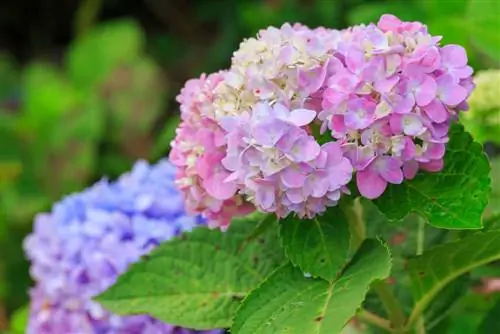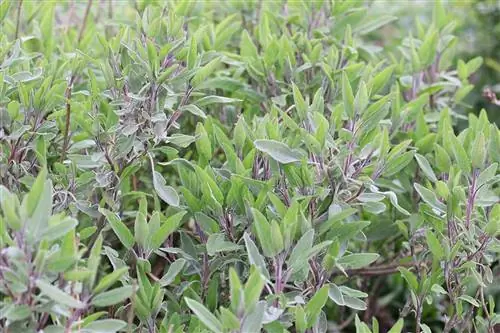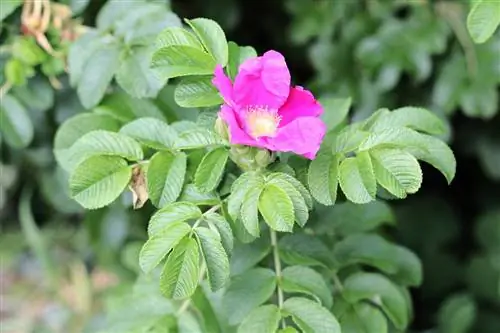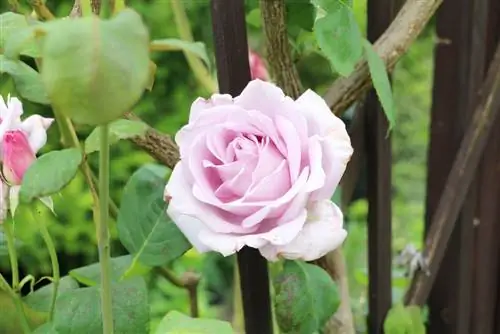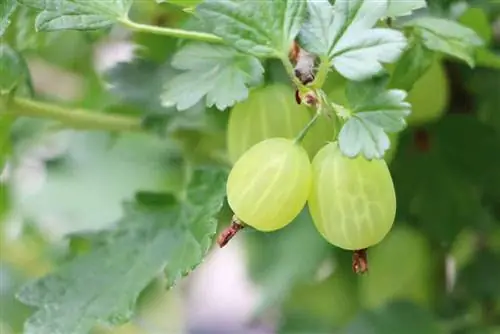- Author admin [email protected].
- Public 2023-12-17 03:39.
- Last modified 2025-01-24 12:45.
The Hydrangea Forever and Ever® is a successful breeding from the species Hydrangea macrophylla (garden hydrangea). Since the Forever and Ever® has been available in garden centers, even the less ambitious hobby gardener no longer has to do without lavishly blooming hydrangeas. She graciously forgives cutting and care errors. Even late frosts don't stop Forever and Ever® from shining with lots of flowers in summer. If you follow a few care tips, you will have a lot of fun with this undemanding hydrangea variety year after year.
Location and soil
The garden hydrangea Forever and Ever® feels most comfortable in partial shade; a shady spot is also acceptable. However, she doesn't like being exposed to the midday sun without protection. The garden hydrangeas also look good in a pot on the terrace or balcony. Normal potting soil and regular fertilizer applications are sufficient. The garden soil outdoors may tend to be moist, but still loose. Even the robust Forever and Ever® cannot tolerate permanent waterlogging. As with other hydrangeas, you can influence the flower colors by changing the pH of the soil. Red-orange varieties retain their color. A blue color is usually desired. For this you need a pH value between 4.0 and 4.5. In this case, rhododendron or azalea soil can be used as flower potting soil. Over time, the soil becomes alkaline, which can be counteracted with appropriate doses of potassium alum or hydrangea blue.
Plants
Planting the Forever and Ever® in the bed is incredibly easy. The planting hole should be dug twice as large as the root ball. You can then fill up with a mixture of garden soil and peat or azalea/rhododendron soil. Adequate watering is then important for rapid growth. The garden hydrangea Forever and Ever® makes a good container plant. For this purpose, choose the largest possible container. It requires a lot of water, so it is important to ensure good drainage. The soil should remain 1-2 cm below the edge of the pot to avoid flooding every time you water. When potting or repotting, it is helpful if some roots are “damaged” or shortened. This measure stimulates the growth of the roots.
Watering, fertilizing
Although the Forever&Ever varieties are very undemanding, they do need water. They should never dry out in the pot. On dry days outdoors must be watered thoroughly. Attention, waterlogging is not desirable! A lack of water can be recognized by leaves hanging limply. Now water quickly and make sure this doesn't happen as often. Because any lack of water means stress for the plant. Especially for blue-flowering hydrangeas, the water for watering should be as soft as possible, e.g. B. Rainwater. Constantly using too hard water causes the flowers to turn pink over time.
In the open field, the hydrangea Forever and Ever® appreciates a dose of organic fertilizer in the spring before the growing season begins. Purchased fertilizer should have a sodium-phosphorus-potassium ratio of approximately 7-6-12.
Cutting overwintering
A big special feature of the Forever and Ever® hydrangeas variety is their joy in blooming. It produces its flowers on annual and perennial wood. In other words, flowers come from every branch. That means you can prune them, but you don't have to. These hydrangeas are cut freely according to the motto: What survives can be cut off. Branches for the vase can also be cut at any time. If you also want to stimulate flower growth, cut the branches a few millimeters above two buds.
Another advantage that speaks for this robust farmer's hydrangea: The Forever and Ever® is ideal for colder climates. It is listed as hardy to USDA Zone 4. That means hardy down to -30°C. These varieties do not require winter protection in the garden. However, a cover in the pot is advisable during longer frost periods below -3°C.
Propagate
Like all other hydrangeas, the Forever and Ever® varieties can be easily propagated from cuttings. To do this, cut off green shoots without flower buds in summer with a sharp knife. One pair of leaves at the top and one at the bottom. The lower leaves are removed. Prepared in this way, the cuttings are placed in the potting soil. If you want to help, you can dip them in rooting powder beforehand. The substrate must now be kept well moist and covered with a transparent film. Ventilate once a day. When placed in a shady location, small roots form after just under two weeks. After another two to three weeks you can place them individually in small pots and grow them further without foil. They stay frost-free and cool in a protected room for the first winter. In spring they can then be put outdoors.
Diseases and pests
With all the robust and easy-care properties of Forever and Ever® hydrangeas, it will come as no surprise to read that diseases and pest infestations only occur very rarely.
The pest infestation, which occurs only slightly, e.g. B. lice are well kept in check in the garden with natural predators such as ladybirds.
Chlorosis can occur from time to time. The young leaves turn yellow and the leaf veins become dark. This is a deficiency symptom: the soil contains too little iron or the iron cannot be utilized properly due to the pH value being too high. This can be remedied by applying appropriate fertilizer.
Tip:
If the older leaves turn yellow during the growing season, this is usually due to a nitrogen deficiency. This problem can also be solved with an appropriate fertilizer (high in nitrogen).
Breeds
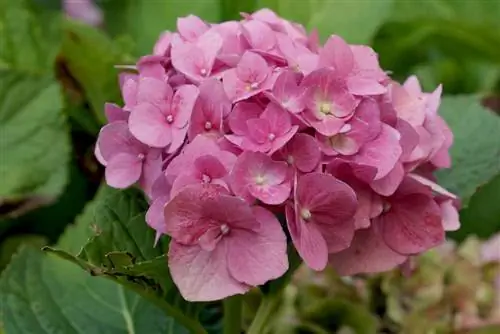
Despite its almost perfect properties, the Hydrangea macrophylla Forever & Ever® was not created through targeted breeding. Rather, it is a chance product of various crosses and was discovered and patented in the USA. There are now many magical new breeds of Forever and Ever®:
- Forever & Ever® 'Pink' - This variety is one of the hardiest varieties, down to -30°C. They bloom all summer long, pink or blue, depending on the pH of the soil.
- Forever & Ever® 'Red' - The color of the flowers of this variety is red. Later, as it fades, the color changes to purple. It is hardy down to -25°C and its flower color does not change.
- Forever & Ever® 'Double Pink' - The flowers of this hydrangea variety are densely filled. The individual balls have a diameter of 15 cm. This variety is also very hardy down to -25°C. The flower color changes, depending on the pH of the soil, they bloom pink or blue.
- Forever & Ever® 'Peppermint' - Its flowers have a white base color. The individual petals form a blue or pink color from their center, depending on the pH value of the soil. The 'Peppermint' is also robust and hardy down to -25°C.
- Forever & Ever® 'Blue' - This hydrangea produces particularly large flower balls that are initially light green and later turn a pure blue. It has particularly beautiful, large, dark green foliage. It is hardy down to -25°C and is also well suited for container planting because of its compact growth.
Conclusion
With the availability of this replanting, extremely easy-care hydrangea variety Forever and Ever®, there is hardly any reason not to plant these baroque beauties in your garden. Their versatility in terms of location and their properties as a container or bed plant are another plus. If you are still unsure whether they are suitable for your own garden, you can easily grow some plants from cuttings.

